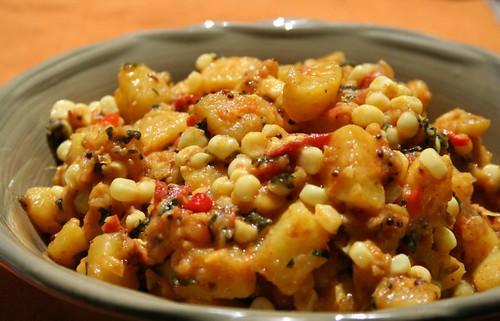
In India, corn or bhutta is usually eaten as a roadside snack, roasted over coal, and then sprinkled with lime and salt, sometimes with red chili powder or spices that would be the vendor's secret, and it is as blissful as it gets. Naturally that is my most favorite way to eat as well as cook corn. First, it needs to be roasted, grilled, or broiled to get evenly dark spots all around. In the meanwhile, in a small plate I take salt, red chili powder, some ghee, and wedges of lime. I dip a lime wedge into ghee, then into the salt and chili powder, and rub it all over the corn. Simple and elegant. Occasionally, I chhidkao (sprinkle) some chaat masala too.
In contrast in America, corn is usually a side as part of a meal or used as an ingredient. My introduction to it, of all places, was in the workplace cafeteria, where it was served alongside my entree. Boiled, and slathered with salted butter, it tasted like nothing I had eaten before. I was completely hooked. Corn here is indeed quite something - tender, succulent, sweet, delicious.
Usually every summer after I have had one corn on the cob too many, there are a couple of them in the fridge that need to be used up, and that is when I turn to one of my favorite dishes made with corn and potato. It is based on a recipe from the book 'Indian Cooking' written by Madhur Jaffrey and is called 'bhutta aur aloo ki mazedar tarkari', which roughly translates to 'a delicious corn and potato vegetable dish'. As with most of Jaffrey's recipes, I increase the amount of chili powder in it slightly. It can be served with rotis, or rice and dal, or eaten by itself.
Bhutta aur Aloo

Serves 3-4
3 Tablespoons oil
1/2 teaspoon mustard seeds
1/2 teaspoon cumin seeds
1 clove of garlic, minced
1 medium potato, boiled and diced
1 medium tomato, chopped
4 Tablespoons chopped cilantro
3 Tablespoons chopped mint
1 green chili, chopped
2 cups of corn (roughly from two cobs)
about 1/2 cup coconut milk
salt to taste
3/4 teaspoon red chili powder
1 Tablespoon lime juice (about 1/2 a lime)
1/4 teaspoon ground black pepper
2 teaspoons ground roasted cumin
In a kadhai or wok, heat the oil and add the mustard seeds. When they start to pop, add the cumin seeds, followed by the garlic and potatoes. Stir fry till the potatoes start to turn golden brown. Add the tomato, cilantro, mint, and green chili. Stir around for a couple of minutes, and then add the corn and coconut milk. Stir it to make sure it doesn't stick to the pan. Lower the heat if needed and cook for a few minutes until the corn is cooked. Add the remaining ingredients one by one.
Notes
I don't always add the mint.
Sometime I substitute the coconut milk with whole milk or half and half.
Instead of using a regular potato, I sometimes use about four fingerling potatoes if I have them on hand, and it makes the dish even more wonderful.






































